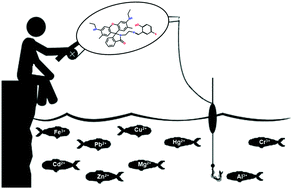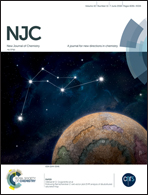A rhodamine-based fluorescent chemosensor for Al3+: is it possible to control the metal ion selectivity of a rhodamine-6G based chemosensor?†
Abstract
A rhodamine derivative, 3′,6′-bis(ethylamino)-2-(2-(2-hydroxy-5-methylbenzylideneamino)ethyl)-2′,7′-dimethylspiro[isoindoline-1,9′-xanthen]-3-one (HL-Me), has been found to be a highly selective and sensitive fluorescent chemosensor for Al3+. It has been synthesized by condensation between N-(rhodamine-6G)lactam-ethylenediamine (L1) and 5-methylsalicylaldehyde (1 : 1) in acetonitrile and characterized by standard methods including single crystal X-ray diffraction analysis. Absorption and emission spectra have been obtained in 10 mM HEPES buffer at pH 7.4 in H2O/MeOH = 1 : 9 (v/v) at 25 °C. In the absorption spectra, HL-Me shows bands at 529 nm in the presence of Al3+. This metal ion turns the colorless solution of the probe to pink. Other metal ions fail to produce any color change. HL-Me is almost non-fluorescent when it is excited at 500 nm. But in the presence of Al3+, the emission intensity at 552 nm increases massively. No other metal ion is able to cause significant enhancement of the emission intensity. HL-Me is colorless and non-fluorescent due to the presence of the spirolactam ring. Al3+ induces the opening of the ring, leading to pink coloration and high fluorescence. Ring opening and the subsequent complex formation with the metal ion have been confirmed by 1H, 13C NMR, IR and other spectral studies. The LOD is determined to be 2.8 nM. The quantum yield and life-time of the probe increase significantly upon complex formation with Al3+. HL-Me has been used for live cell imaging studies with different prokaryotic and eukaryotic cells. Reactions of L1 with salicylaldehyde with varying derivatives produce different rhodamine-based probes for different analytes. An attempt has been made to categorize the probe based on the substituent present in it with metal ion selectivity.



 Please wait while we load your content...
Please wait while we load your content...